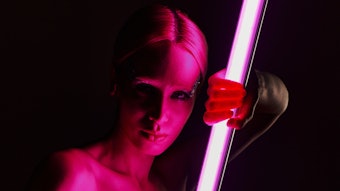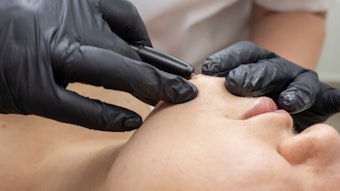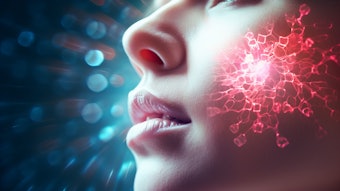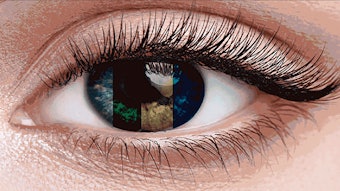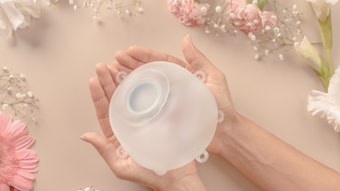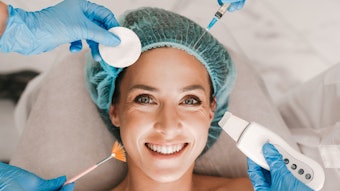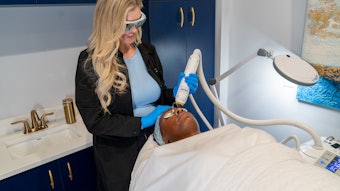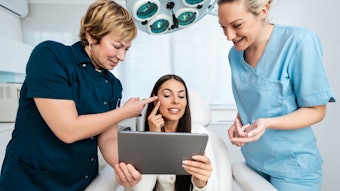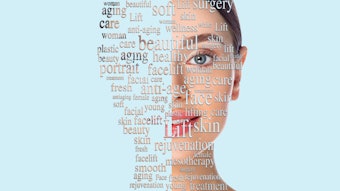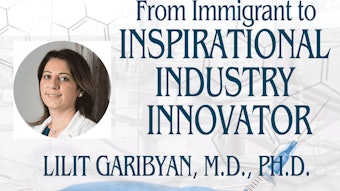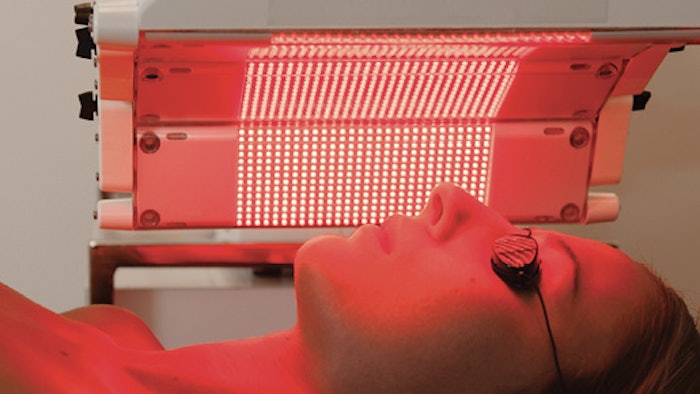
New benefits and research for this time-tested modality.
Light therapy has come a long way since its inception in the late 1960s. Originally used to heal tissue from sports injuries and wounds, low-level light therapy uses red and infrared light to ignite the cells into repair mode. This accelerates healing, enabling patients to get moving faster and improve their overall well-being. Dermatologists are starting to offer the treatment as well as become specialized in key areas. Because light therapy achieves a variety of skin-repairing results, it’s another offering in a top practice’s arsenal of aesthetic treatments. Always seeking innovative ways to address patient needs and provide succinct information, MedEsthetics spoke to professionals specializing in cosmetic enhancements to get their take on this growing trend.
How Does Light Therapy Work?
Light therapy, or light emitting diode (LED) therapy also known as photobiomodulation (PBM) and previously called low-level light therapy (LLLT), is the application of specific wavelengths of light energy to tissue for therapeutic benefits. The light slows oxidative stress and increases ATP with proper light intensity. This goes to work in powering the cell’s metabolism to speed repair and regeneration. Like many physical treatments that were founded upon physical ailment relief, PBM is growing in the aesthetics field for its proven methods of improving skin and body concerns. Noted for its ability to reduce inflammation, scar tissue and resurface skin, more practitioners are warming up to the idea of photo light therapy.
“Phototherapy creates a cascade of biochemical reactions within the target tissue, energizing cellular function by increasing ATP production resulting in the stimulation of collagen, improvement of skin laxity and the reduction of pigmentation,” stated Jared Jagdeo, M.D., M.S., Director of Photomedicine at SUNY Downstate Health Sciences University.
During treatment, specialized tools are placed on the affected area to help light photons absorb into the skin. These then affect the cells to achieve photophysical and photochemical change. The results include improved healing, circulation, pain reduction, and better overall cell and tissue activity. For the aesthetic industry this translates into better looking, younger-acting skin and muscles.
The easiest way to describe PBM or light therapy to your patients is to make the analogy to plants going through photosynthesis to produce chlorophyll. Just like photosynthesis, the effects of PBM are photochemical. While plants require light to generate healthy, new, green cells, skin responds to low level light therapy by creating new cells.
Non-Invasive, Proven Skin Enhancement
Light therapy is a proven winner among practices and patients alike. WIth zero downtime, incrementally better results, and healthier, younger-acting skin, it’s a great addition to your offerings. For those unhappy with the state of their skin, they can sit back and relax during a light therapy treatment. Some of the in-office benefits include no prescriptions, injections, surgery, or post care regimen. Your patients can enjoy some “me-time” while the technology does the work of improving their skin, cell by cell.
Healing wounds and injuries is just the tip of the iceberg for the aesthetic community in using light therapy, however. Research has shown that the treatment can increase circulation, accelerate tissue repair, kill acne bacteria, decrease inflammation, improve skin tone, texture and clarity, decrease the appearance of fine lines and wrinkles, as well as ease muscle and joint pain, stiffness, spasm.
Red or near-infrared light creates energy to stimulate the healing properties of cell and tissue regeneration. This helps to accelerate the building of collagen and elastin by increasing blood flow and mitochondrial function. With non-invasive, painless light therapy, collagen and elastin is produced helping improve fine lines and wrinkles, scarring, and skin texture, as well as reduce stiffness and pain from arthritis.
When Should Light Therapy Be Used?
The process of photo or light therapy is gaining popularity in the medical community as more research and testimonials attest to its unique capabilities. Practice owners like the option of another modality to correct skin issues, pain management, and even hair restoration.
Some of the top indications that LED photobiomodulation works for aesthetic procedures comes from the clinical research our experts rely on. Their enthusiasm for the therapy is validated through their patients’ responses of clearer, tighter skin, less pain in affected areas and improved hair growth. Their scientific research matches these claims through the instances of increased cell proliferation and migration, increased blood flow and tissue oxygenation and modulation of key cellular growth factors and mediators.
Dr. Jagdeo shared that clinical research shows “the primary effect of light is targeted on cellular mitochondria, causing an increase in cellular adenosine triphosphate (ATP) and changes in cell homeostasis that leads to a cascade of reactions called secondary reactions. These secondary reactions are the reasons why we see changes to the skin as a result of light therapy treatments.”
Is the Investment in Light Therapy Just Hype?
You and your patients are probably wondering what treatment is best for their specific issues. Research is being done all the time in regards to low-level light therapy and its effectiveness in treating a variety of conditions. One of the newest indications for use is for hair restoration.
Denise Ryan, Celluma vice president of brand management, shared with us that “light therapy for hair can be an effective stand-alone therapy or adjunctive therapy to medication and topical prescriptions for optimal hair regrowth.” Dermatologists and medical practitioners specializing in hair restoration can ensure proper diagnosis and treatment recommendations. Individuals should consult with their physician for a correct diagnosis and to determine if light therapy is suitable for their category of hair loss.
For those looking for validity, there is confidence in a review article, stating that, “relative effects show LLLT as the superior treatment” when comparing light therapy to the six most common non-surgical treatment options for treating androgenetic alopecia in both men and women including dutasteride 0.5 mg, finasteride, 1 mg, minoxidil 2%, minoxidil 5% and platelet-rich plasma (PRP). Patients that need a boost in hair growth can opt for photo light therapy for ongoing results.
Patients with pain issues like sports injuries have been enjoying the benefits of LED therapy for decades. With the ongoing pursuit to the fountain of youth, making phototherapy a staple in your office is a win-win. “Younger patients struggling with acne are seeking relief that won’t irritate their skin. We’ve seen great success using LED light therapy like BBL (Broad Band Light) treatment” states Anna Pare, M.D., president of Dermatology Consultants.
For those disappointed with discoloration from rosacea or sun spots, small facial veins, fine lines and wrinkles, or uneven texture, light therapy is a simple option that many of her medical professionals reach for. “It provides a smoother, clearer complexion and that boost of confidence our patients are seeking. Combined with other treatments like microneedling and retinoids, my patients are finally able to achieve their skin goals,” she said.
What Wavelengths Have the Best Evidence for Efficacy?
The effects of light therapy depend on the application of the correct wavelength and density of light, delivered to the target tissues for an appropriate period of time (typically between 30 - 60 seconds). Pulses can improve tissue repair and anti-inflammatory effect, analgesia is best achieved with a continuous beam. Using wavelengths that are readily absorbed by chromophores in the cell membrane and the mitochondria, allows them to penetrate deep enough to reach the targeted cells. This is imperative in achieving the desired result, and usually takes a series of treatments.
These wavelengths are in the visible range to just outside the visible range, from 400-1000nm. Within this range fall the scientifically proven blue, red and near-infrared wavelengths. Blue is very effective at killing acne bacteria, however, blue wavelengths are too short to affect cells in the dermal layer. Red and near-infrared wavelengths reach deeper levels and are extremely effective at increasing metabolic responses. This enables devices to manage a wide range of skin issues.
415nm (Blue Light) – Mild to Moderate Acne Vulgaris, PDT
Your patients will feel even more assured knowing that the FDA has approved these devices for all therapies.
Among patients and dermatologists, the evidence speaks for itself when it comes to light therapy's ability to relieve acne and its tell-tale signs of scarring. Blue light works to eradicate acne-causing bacteria while the red light gets those cell mitochondria pumping to help reduce inflammation. Physicians can combine this treatment with their standard prescriptions and other acne treatments to really enhance patients’ skin.
633nm (Red Light) – Periorbital Wrinkles, Hair Growth
“Within the skin are cellular components which we target with specific wavelengths of light to induce a clinical response. Red LLLT targets the cellular mitochondria (specifically the cytochrome oxidase), commonly referred to as the battery of the cell,” said Dr. Jagdeo. Red
and near infrared light slows oxidative stress and increases ATP, stimulating the healing properties of cell and tissue regeneration.
Denise Ryan describes, “red light LED devices have been cleared by the FDA for the treatment of male and female pattern hair loss. Substantial research has supported light therapy’s ability to regrow hair lost due to androgenetic alopecia with minimal degrees of side effects and adverse events.”
830nm (NIR Light) – Pain, Collagen Production
The wavelength of 830 nm offers deep penetration into living biological tissue. It has anti-inflammatory effects and helps reduce erythema, edema and bruising, and enhances fibroblasts to speed healing. Many practitioners use this wavelength immediately post-procedure, to improve patient downtime while significantly speeding up wound healing.
Continue Good Patient Care at Home
Like all good skin treatments, there have been significant advancements in LED devices in recent years. Modern technology has helped the industry keep pace with better, faster treatments for a variety of patient concerns. In office, patients receive specialized treatment to complement their overall skin health.
Home-use devices are now able to deliver similar results to in-clinic treatments so patients can continue treatments for long-term self care. “The Omnilux Contour & Clear range of home use devices have helped enhance the results of my clinic procedures for my patients and are also a great stand alone treatment for wrinkle reduction and acne,” mentioned Dr. Jagdeo.
The Celluma line is gaining happy customers who like their treatments backed by science. They state that “scientific research indicates that cells absorb particles of light (photons) and transform this energy into adenosine triphosphate (ATP), the form of energy that cells utilize.”
These devices are easily and safely used at home by patients of all ages and skin types. Benefits include moisture retention, reduced redness and inflammation, reduced line depth and overall plumper, healthier skin with continued use. The practitioners we spoke with encourage them to start with in-office procedures for an initial boost before maintaining positive results at home.
Conclusion
The experts we spoke with mentioned that no matter what your patient’s skin concerns, if they are disappointed with their skin in any way, they can benefit from the gentle treatment of light therapy. Those disappointed with stubborn acne scarring, fine lines and wrinkles and thinning hair want effective remedies. Long since the time of just being used for wounds and injuries, the unique modality is helpful for a variety of common conditions. In the aesthetics industry, the treatment expands to not only feeling better, but stimulating the body and skin to look and act younger. More and more, the physicians we speak with are mentioning how their patients are seeking advanced methods of combating skin issues stemming from years of external damage and poor habits.
Being a non-invasive, non-toxic and painless treatment makes light therapy a great choice for any patient with ongoing skin issues.
Mara Maddox is a freelance writer and public relations specialist with a background in branding and marketing for the upscale, consumer retail market. She has contributed to the International Society of Aesthetic and Plastic Surgeons (ISAPS) as well as a variety of plastic surgery centers and the integrative aesthetics industry.
